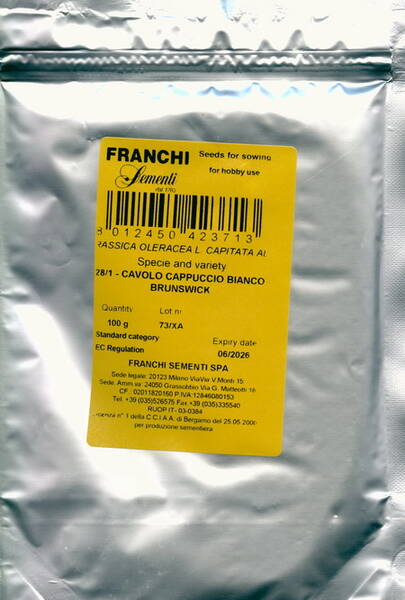Ex Tax: 12.75€
Variety for sauerkraut.
A medium-earliness kind. This kind is characterized by its good taste and a high amount of sugar and vitamins. The crop is harvested 120-130 days after the planting of the seedlings.
The cabbage heads are stiff, light-green in colour and weigh approximately 2.5-3.5 kg. Can be eaten fresh and are especially suitable for fermenting, also can be stored.
1,0 g contains approximately 350 seeds.

* Fermentation.
To obtain 100 kg of sauerkraut, 112 kg of fresh peeled cabbage is consumed. To this amount of cabbage add 1.7-2 kg of salt. You can also add peeled and chopped carrots (3 kg), apples (8 kg), lingonberries and cranberries (1-2 kg each), cumin (50 g), bay leaf (20-30 g), anise and allspice (each taste), respectively, reducing the mass of cabbage taken.
Use cabbage of late or mid-season varieties. Early ripe varieties are not suitable for pickling. Ripe, but not overripe heads of cabbage are selected, without cracks and signs of disease, not frostbitten and not steamed. Heads of cabbage are cleaned, green and damaged white leaves are removed, and a stalk is cut out, chopped. Apples are washed, and large ones are cut into pieces, removing seed nests. Cranberries and lingonberries are sorted and washed in cold water. Shredded cabbage is lightly rubbed with salt, and mixed with apples and cranberries. Tightly placed in a barrel, tamping. A layer of cleanly washed green cabbage leaves is placed on the cabbage in a barrel, covered with a double layer of scalded canvas or gauze, and then a wooden circle and oppression are placed. The weight of oppression should be no more than 10% of the weight of the cabbage. The underbelly circle should always be covered with cabbage juice.
On the 2-4th day after laying the cabbage (at room temperature), the first signs of fermentation appear as turbidity of the juice, gas bubbles. In the future, abundant foam is formed, and the juice becomes even more cloudy. The foam is regularly removed. + 18 + 22 ° С is considered the best fermentation temperature, in these conditions, it ends in 10-12 days. When the temperature drops, fermentation is delayed, which is undesirable, as it leads to a deterioration in the quality of the product. A sharp increase in temperature is unacceptable because it contributes to the development of butyric fermentation (especially in the depths of the barrel), the appearance of an unpleasant taste and smell in the product. During fermentation, it is useful from time to time to pierce the mass of cabbage in the barrel with a smooth, well-washed and scalded wooden stick. This helps to remove gases that accumulate during fermentation.
Characteristic signs of the end of the fermentation process are the clarification of the brine, the cessation of gas emission, and the subsidence of cabbage. Cabbage acquires a pleasant refreshing sour-salty taste, juiciness, elasticity, crunch on the teeth, and a characteristic aroma.
When storing sauerkraut, care must be taken to ensure that it is always covered with brine. This contributes to the preservation of vitamin C. Sauerkraut should be stored in a cool place. The best storage temperature is around 0°C.
Eng.: White Cabbage. Suom.: Keräkaali (valkokaali). Sven.: Vitkål.












